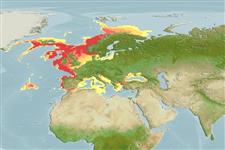Common names from other countries
Classification / Names / Names
народные названия | синонимы | Catalog of Fishes (gen., sp.) | ITIS | CoL | WoRMS
Environment: milieu / climate zone / depth range / distribution range
экология
; пределы глубины 0 - 1250 m (Ref. 85345). Temperate; 76°N - 1°S, 33°W - 36°E
Atlantic and the Mediterranean Sea: Belgium and Germany. Temperate and subtropical.
Length at first maturity / Size / Вес / Возраст
Maturity: Lm ? range ? - ? cm Max length : 1.5 cm BL самец/пол неопределен; (Ref. 7882)
Oval, flattened body measuring up to 1.5 cm long for species from the North Sea off Belgium (Ref. 7882). Found along the near-coastal and coastal zones usually in medium- to coarse-grained sand with low mud content (maximum of 10%). Turns completely green in color when injured (Ref. 7882). Also occurs on substrates exposed to extensive waves and tidal activity and found on shelly gravel (Ref. 121547).
Life cycle and mating behavior
половая зрелость | размножение | нерест | икра | Fecundity | личинки
Members of the class Echinoidea are gonochoric. Fertilization is external. Brooding is common, eggs are held either on the peristome, around the periproct or deep into the concavities on the petaloids. Life cycle: Embryos develop into planktotrophic larvae (echinoplateus) and live for several months before they sink to the bottom using their tube feet to adhere on the ground where they metamorphose into young urchins.
Основная ссылка
ссылки | координатор | соавторы
Harms, J. 1993. (Ref. 2711)
Статус Красного Списка МСОП (Ref. 130435)
Статус СИТЕС (Ref. 108899)
Not Evaluated
Not Evaluated
Использование человеком
| FishSource |
инструменты
дополнительная информация
ресурсы в Интернет
Estimates based on models
Preferred temperature
(Ref.
115969): 5 - 11.3, mean 7.3 (based on 241 cells).
Категория цены
Unknown.
